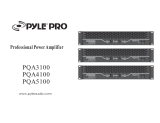
MC68336/376 QUEUED ANALOG-TO-DIGITAL CONVERTER MODULE MOTOROLA
USER’S MANUAL Rev. 15 Oct 2000 8-8
when the CPU32 is not in supervisor mode and when the space is programmed as
supervisor space, causes a value of $FFFF to be returned. Attempts to write supervi-
sor-only or supervisor-assigned data space when the CPU32 is in user mode has no
effect.
The supervisor-only data space segment contains the QADC global registers, which
include QADCMCR, QADCTEST, and QADCINT. The supervisor/unrestricted space
designation for the CCW table, the result word table, and the remaining QADC
registers is programmable. Refer to D.5.1 QADC Module Configuration Register for
more information.
8.6.4 Interrupt Arbitration Priority
Each module that can request interrupts, including the QADC, has an interrupt arbitra-
tion number (IARB) field in its module configuration register. Each IARB field must
have a different non-zero value. During an interrupt acknowledge cycle, IARB permits
arbitration among simultaneous interrupts of the same priority level.
The reset value of IARB in the QADCMCR is $0. Initialization software must set the
IARB field to a non-zero value in order for QADC interrupts to be arbitrated. Refer to
D.5.1 QADC Module Configuration Register for more information.
8.7 Test Register
The QADC test register (QADCTEST) is used only during factory testing of the MCU.
8.8 General-Purpose I/O Port Operation
QADC port pins, when used as general-purpose input, are conditioned by a synchro-
nizer with an enable feature. The synchronizer is not enabled until the QADC decodes
an IMB bus cycle which addresses the port data register to minimize the high-current
effect of mid-level signals on the inputs used for analog signals. Digital input signals
must meet the input low voltage (V
IL
) or input high voltage (V
IH
) specifications in
APPENDIX A ELECTRICAL CHARACTERISTICS. If an analog input pin does not
meet the digital input pin specifications when a digital port read operation occurs, an
indeterminate state is read.
During a port data register read, the actual value of the pin is reported when its corre-
sponding bit in the data direction register defines the pin to be an input (port A only).
When the data direction bit specifies the pin to be an output, the content of the port
data register is read. By reading the latch which drives the output pin, software instruc-
tions that read data, modify it, and write the result, like bit manipulation instructions,
work correctly.
There are two special cases to consider for digital I/O port operation. When the MUX
(externally multiplexed) bit is set in QACR0, the data direction register settings are
ignored for the bits corresponding to PQA[2:0], the three multiplexed address MA[2:0]
output pins. The MA[2:0] pins are forced to be digital outputs, regardless of the data
direction setting, and the multiplexed address outputs are driven. The data returned
Frees
cale Semiconductor,
I
Freescale Semiconductor, Inc.
For More Information On This Product,
Go to: www.freescale.com
nc...




















